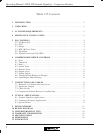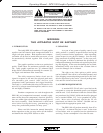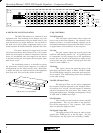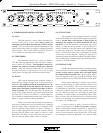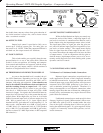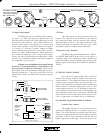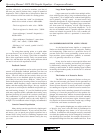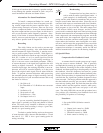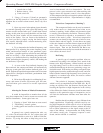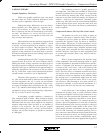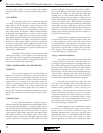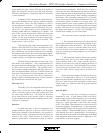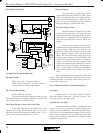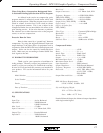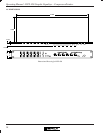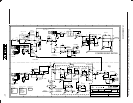
10
Operating Manual - DPX-100 Graphic Equalizer - Compressor/Limiter
e. Attack time to 5mS.
f. Release time to 1 Sec.
g. Limit switch IN
2. Using a 1/3 octave (31 band) or parametric
equalizer, set the EQ controls to a flat setting, and if the
equalizer has an overall volume control, boost it by 10 to
15 dB.
3. Open up several microphone input channels
to a normal operating level, with typical EQ settings, and
turn the console master fader up to a louder than normal
setting. At this point, the system should be well into feed-
back, but the room volume will be constant due to the
action of the limiter. You can listen to the feedback at
any level you like by simply varying the limiter output
level control, although below a certain monitoring level,
the feedback will stop.
4. Try to determine the feedback frequency, and
then equalize it by adjusting the center frequency, band-
width, and boost/cut controls of your parametric equal-
izer. (Note: a graphic equalizer can also be used, although
with less accuracy.) After eliminating the problem fre-
quency, try to further define it by sharpening up the band-
width, reattacking the frequency control, and making the
cut shallower, if possible.
5. As soon as the first feedback frequency has
been removed, the compressor/limiter will automatically
bring up system gain until another feedback point is in-
duced. Repeat the equalization procedure until it becomes
impossible to distinguish individual, predominant feed-
back frequencies.
6. Write down EQ marks for safekeeping if nec-
essary, and return all mixer, EQ master gain, and com-
pressor/limiter gain controls to normal operational
settings.
Altering the Texture of Musical Instruments
It would be impossible to mention here all the
ways that compression is used to create new sounds with
familiar instruments. Some typical uses are:
1. Creating a “fatter” kick drum or snare sound.
2. “Thickening” acoustic guitars.
3. Adding punch and sustain to electric bass or
guitar.
In general, use a gentle compression ratio, say
4:1, with a 10 mS attack time, 0.1 Sec. release time, and
a low enough threshold to cause 6 to 10dB of Gain Re-
duction. Try using this effect to help bring out a lead
vocal or instrumental solo in a cluttered mix. The com-
pressor is also a great corrective tool when working with
singers whose own dynamic control is less than perfect.
A little compression helps to keep their quieter lines from
becoming buried in the mix. Experimentation is highly
recommended.
Voice-Over Compression (“Ducking”)
The compressor/limiter can be used to automati-
cally reduce music to a background level when an an-
nouncer is speaking. In this scheme, only the music signal
is actually gain-reduced by the limiter. However, the de-
tector is connected to respond to an announcer’s voice
instead of the music’s peaks. Voice-Over compression
assumes you are already using some sort of mixer to com-
bine the music and mic signals. Use the direct out (send)
of the mic channel to feed the detector input on the CLX
unit. Note: Be sure to use a mono plug for the CLX
detector input. Then use the Threshold and Ratio con-
trols to determine when and by how much the announcer’s
voice affects the music level.
De-Essing
A special type of saturation problem often en-
countered in recording is the sibilant (Ssss) sound of the
human voice. High frequency, sibilant sounds can reach
very high energy levels, so that a voice that is otherwise
undistorted breaks up on the esses, producing a raspy, un-
desirable sound. With analog recording to magnetic tape,
high frequencies tend to saturate the tape sooner, and com-
bined with the internal high frequency boost (record pre-
emphasis) on standard tape decks, the need to control
sibilants becomes apparent.
The solution is frequency-dependent limiting,
which is easily accomplished with the DPX-100. By in-
serting an equalizer into the Detector Patch point and
boosting the equalizer at high frequencies in the vicinity
of the sibilant, the limiter’s detector circuit becomes more
sensitive to this particular range of frequencies, and so
will limit the bothersome sibilants more than other fre-
quencies.
Realize that this technique is very different from
simple equalization. Equalizing a sibilant vocal by cut-
ting high frequencies would result in a loss of important
high frequency information at all times, whereas de-essing
has no effect whatsoever on the signal except at the in-
stant of the sibilant. At that moment, the Ashly limiter
will reduce overall gain. Frequency response is unaf-
fected, and the sibilant is controlled.



